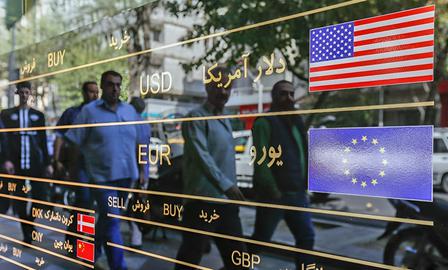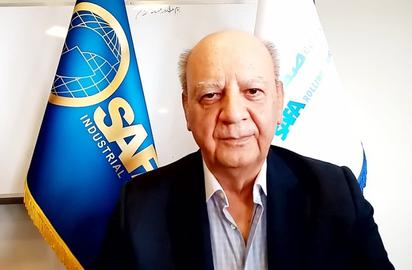A precise portrayal of the dire state of Iran's currency, the Rial, lies somewhere between helplessness and imminent threat, as articulated by Mohammad Reza Farzin, president of the Central Bank.
Concluding a conference themed around "Resistance Economy," Farzin implored attendees, whom he hailed as pivotal in policy formation, to safeguard the Rial from further deterioration.
He emphasized the critical role of the Rial in Iran's entire financial infrastructure, warning that its destabilization would have catastrophic repercussions for the nation's financial stability.
Iran's monetary policy architect cautioned, "The Rial faces increasing competition today. Various sectors openly flaunt the use of gold bullion, cryptocurrencies, and dollars in substantial transactions. Legal intervention is imperative, prohibiting any currency other than the Rial in domestic dealings."
Farzin's warnings and admonitions acknowledge and attempt to fulfil a key duty of central banks: maintaining the value of the national currency which the Islamic Republic's central bank has failed since the 1979 Islamic Revolution.
Farzin's observations paint a grim picture of the Rial's sovereignty waning within its borders, a trend persisting for many years.
Businesses, knowing about the Rial's future, increasingly turn to alternative currencies and assets for wealth exchange and storage, prompting the invocation of legal and coercive measures to curb this behaviour.
The utilization of gold, foreign currencies, or dollars in real estate transactions is not novel.
Media reports of such practices emerged at least since the currency shock of summer 2018, if not earlier.
The main issue is that official authorities have ignored or denied this behaviour for too long. Farzin's speech marks a major step in recognizing the widespread use of foreign currency or dollarization in Iran, a reality that cannot be ignored any longer.
The question arises: what has precipitated this widespread embrace of currency substitution or dollarization? Why have trade unions and economic players fervently shunned the Rial to the extent that the nation's monetary policy chief issues dire warnings?
The primary cause of such a phenomenon must be attributed to the persistent and recurring crises within the macroeconomic environment, coupled with the instability prevailing in this domain.
One example of this crisis is the transmission of inflation fluctuations, which is not over 40 per cent.
In an economy plagued by exceptionally high and chronic inflation rates, it's only natural for economic actors to seek havens to safeguard their value and wealth.
Consequently, the national currency relinquishes one of its fundamental roles - that of preserving wealth and serving as a store of value - prompting economic agents to substitute it with a more stable foreign currency or alternative commodity.
The volatility in currency markets in recent years, exacerbated by severe price shocks, has further accelerated the exodus from the Rial, perceived as an unreliable and depreciating currency.
For over half a century, the Rial has remained largely isolated on the international stage, absent from the global foreign exchange (forex) market.
Apart from a handful of neighbouring nations, there are scant opportunities for Rial exchange and trading, rendering it unrecognized and inaccessible in most countries.
When combined with the ongoing and substantial decline of the Rial against other currencies in local markets, Mohammad Reza Farzin's complaints represent the most logical and predictable reaction from economic participants.
During Farzin's tenure as the president of the central bank from December 2022 to the present day, the Rial has suffered a significant depreciation, losing a quarter of its value against the dollar.
According to data from the Deadlock website, when Farzin assumed the position, each US dollar was valued at 430,000 Rials in the open market.
Presently, the exchange rate has surged to over 600,000 Rials per US dollar.
The management of the currency system is intricately linked not only to variables such as inflation, interest rates, and monetary policy behaviour but also to the currency pricing mechanism in conjunction with other economic policies such as financial and commercial strategies.
The government supports direct asset exchanges without involving the Rial, especially internationally for transactions like oil, tea, wool, livestock, or construction projects. However, it takes a different approach with individual economic players, resorting to complaints and warnings instead.
Simultaneously, certain central bank policies have exacerbated this situation.
To offset the limitations on repatriating dollars and euros to the country due to sanctions and Iran's inclusion in the FATF blacklist, the Central Bank and the government opted to streamline the importation of gold bullion and leverage it to settle foreign exchange obligations, thereby facilitating the return of export currencies.
However, the ramifications of this policy became evident shortly after its implementation.
Reports published regarding the establishment of a network for leasing gold bullion and the reverse smuggling of these assets indicate that some exporters were utilizing these networks to evade the compulsory return of their export proceeds.
Furthermore, the accumulation of gold bullion prompted a shift in central bank policies.
Initiatives such as the auctioning of gold bullion in the gold and currency exchange centre, along with the mandate for exporters to supply their bullion to this market to fulfil their obligations, exemplify these alternative measures.
The criticism from the president of the Central Bank towards certain guilds engaging in substantial transactions using gold bullion highlights how, in practice, the Central Bank has replaced the Rial with gold bullion in significant transactions.
However, the concerning aspect of the monetary policymaker's approach is how he deals with the spread of this issue.
It reflects a common trend within the governance system of the Islamic Republic, which heavily relies on enforcement, punishment, and criticism.
The president of the Central Bank of Iran simply expresses regret over the decreasing importance of the Rial in trade and domestic economic activities, urging legal action.
This approach, persisting across different areas for more than four decades, has not produced significant outcomes.
visit the accountability section
In this section of Iran Wire, you can contact the officials and launch your campaign for various problems























comments